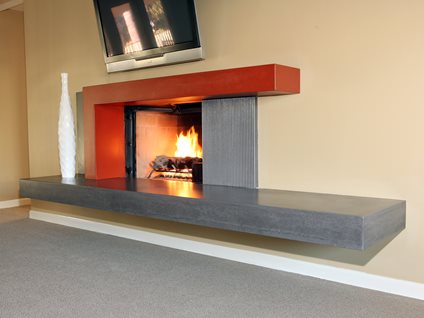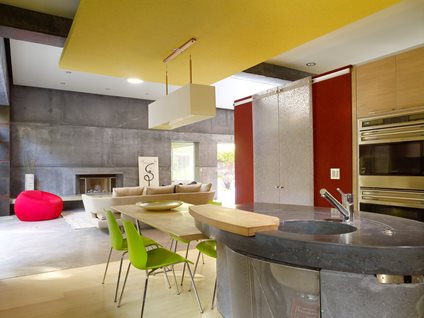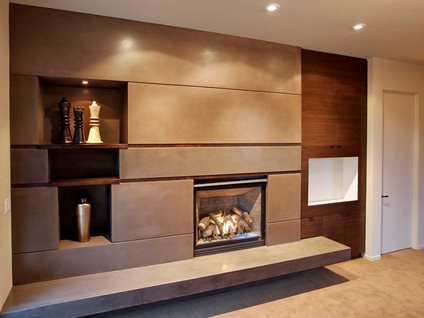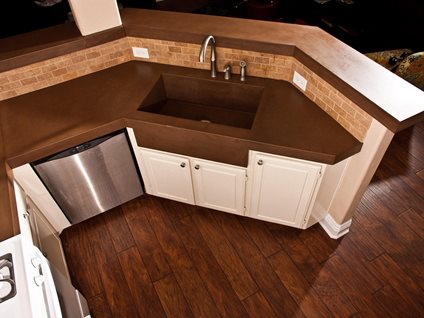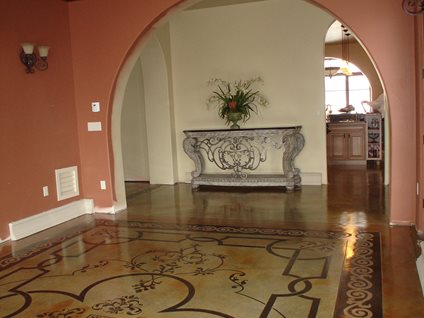- Staining Concrete
- Stamped Concrete
- Concrete Overlays
- Concrete Resurfacing
- Concrete Polishing
- Concrete Dyes
- Colored Concrete
- Indoor Concrete
- Concrete Floors
- Concrete Countertops
- Garage Floor Coatings
- Furniture, Sinks, Fire Bowls
- Basement Floors
- Outdoor Concrete
- Concrete Patios
- Concrete Driveways
- Concrete Pool Decks
- Outdoor Kitchens & Counters
- Outdoor Fireplace
- Concrete Walkways
- Concrete Pavers
- Concrete Walls
- Repair & Maintenance
- Foundation Repair
- Concrete Crack Repair
- Concrete Sealers
- Building with Concrete
- Concrete Homes
- Concrete Basements
- Decorative Concrete
- Fire Resistant
Design Secrets for Interior Concrete
Using design principles to integrate decorative concrete into an interior design schemeWhile many homeowners love the look of concrete floors, countertops, fireplace surrounds and bathroom vanities, they often have no idea how to incorporate decorative concrete into their own interior design schemes. The unlimited design options that make decorative concrete so desirable can also be overwhelming when it comes to deciding on the best colors, patterns, shapes and textures to use. To bring your design plans into focus, try applying some basic principles of interior design. See examples below of how to use balance, repetition, continuity, focal points, and contrast to create beautiful concrete-enhanced interiors.
Balance
Balance is necessary to achieve visual weight in a room. But it doesn’t have to be perfectly symmetrical. For a more informal and intriguing look, try an asymmetrical approach, such as this yin-yang inspired concrete fireplace surround.
Focal points
If concrete is to be used as a focal point in a room, make sure it commands attention and attracts the eye. The focal point of this kitchen is a charcoal-colored, oval-shaped concrete island, with a built-in cutting board and a concrete sink. Concrete countertop designer Fu-Tung Cheng used this shape rather than an ordinary rectilinear island to create a sculptural element for the space. See more photos of the work Cheng designed for this unique home.
Contrast
When done thoughtfully, pairing other materials with concrete creates stimulating visual contrast without being distracting. This beautiful floor-to-ceiling fireplace surround, designed for the master bedroom of a model home, is made of two-toned taupe and gray concrete enhanced by rusted, forged metal band inlays and walnut shelving. See other examples of how concrete was used in the interior rooms of this home.
Repetition
Even when you combine concrete with other materials in a room, you can achieve cohesiveness by repeating forms, textures or colors. In this kitchen, for example, the dark wood floors are echoed in the rich, walnut-colored concrete countertops.
Continuity
The design challenge in this home was to tie multiple rooms and hallways together to provide continuity yet have unique looks within each room. To create the multiple looks, decorative concrete floors with different stenciled patterns were used. However, the same two base floor colors and the same border design extend throughout the house to maintain a cohesive flow. In areas with light floors the borders were dark, and on the dark floors the borders were light.
Related:
Beauty of Collaborative Design
Indoor Concrete Style Palettes
